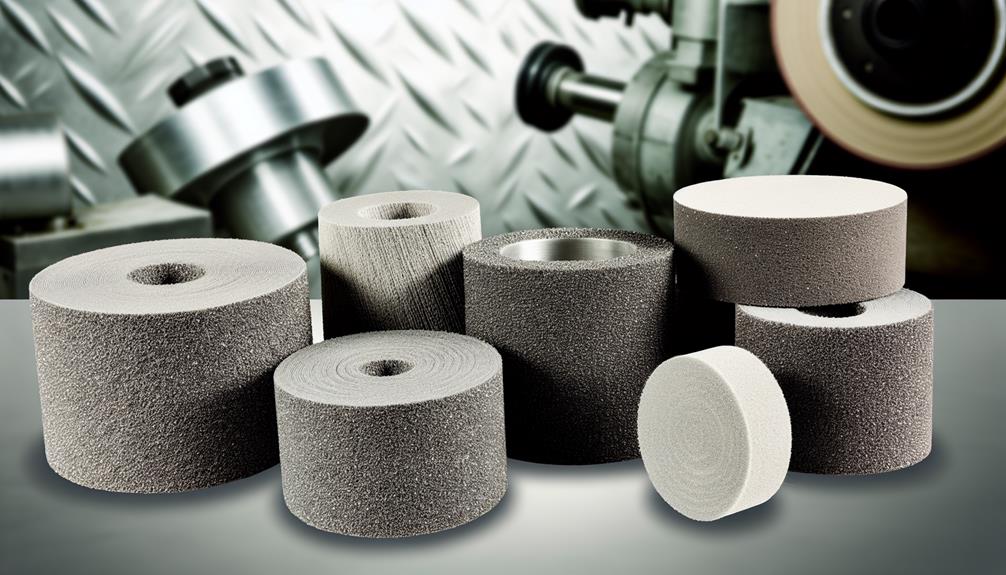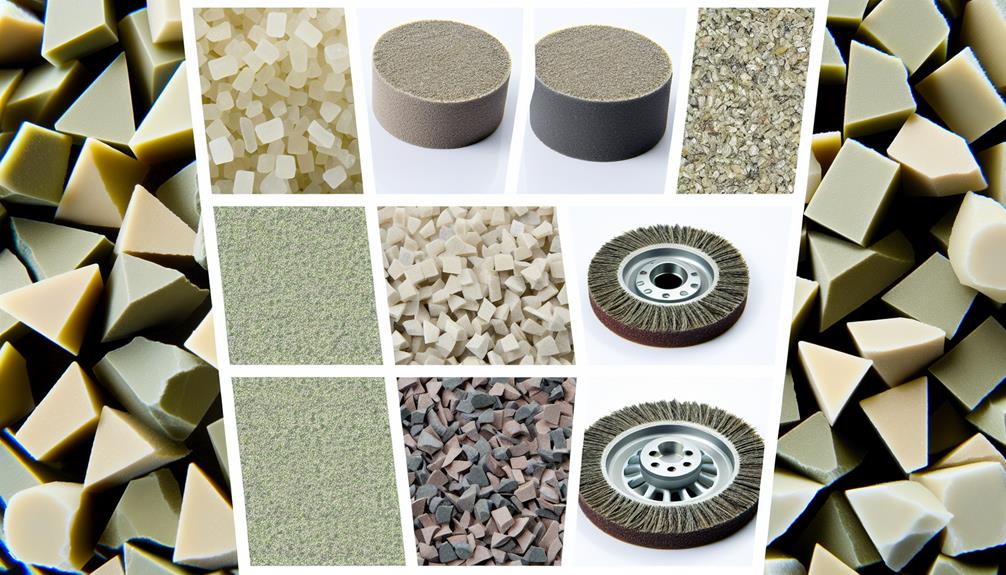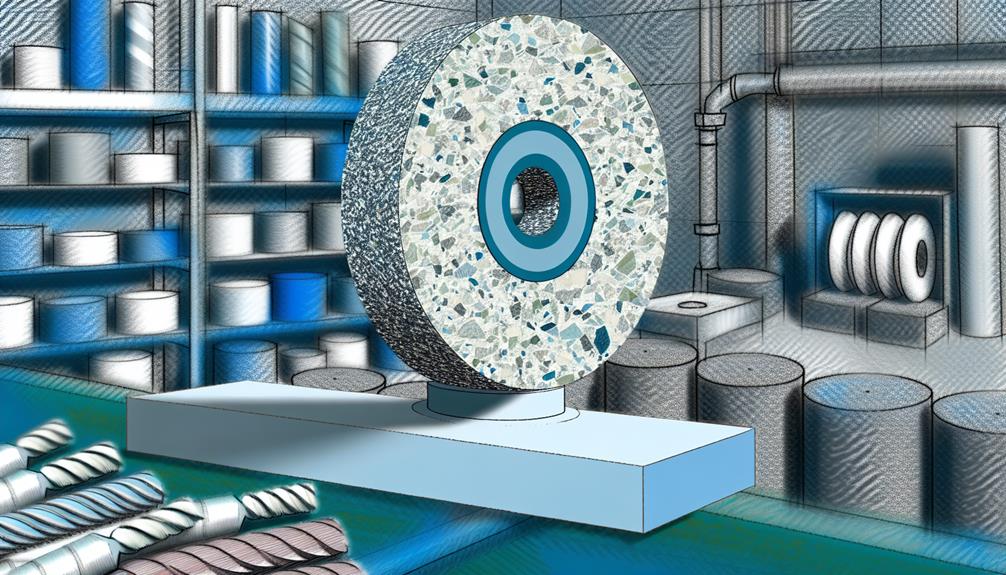In the realm of abrasive technologies, the selection of the appropriate material for grinding wheels is pivotal, influencing both the efficiency and outcome of surface finishing processes. Each abrasive type, from aluminum oxide to silicon carbide, ceramic, and beyond, carries inherent properties that tailor it to specific grinding tasks. For instance, aluminum oxide is renowned for its durability and is favored for grinding high-tensile materials, while silicon carbide is preferred for its sharpness and compatibility with non-ferrous metals. As we navigate through each abrasive type, consider how the unique characteristics of these materials impact their performance in various grinding scenarios. This exploration not only broadens our understanding but also enhances the precision and effectiveness of our material processing techniques.


Aluminum oxide, a robust and versatile abrasive, is predominantly utilized in grinding wheels for its excellent hardness and durability. This material, also known as alumina, is derived from bauxite ore and represents a major component in the field of abrasive technology. Its crystalline form allows for efficient cutting under rigorous conditions, making it ideal for high-tension applications that demand precision and control.
Aluminum oxide abrasives are classified into different types based on purity and processing methods, which directly impact their performance characteristics. The most common forms used in industry are white, pink, and brown aluminum oxide, each tailored for specific grinding tasks. White aluminum oxide is highly pure, making it suitable for precision grinding of high-strength steel and other ferrous alloys.
Brown aluminum oxide, slightly less pure, is often employed in general-purpose grinding operations. Pink aluminum oxide offers a good balance between hardness and toughness, which is essential for tool sharpening.
Opting for aluminum oxide in grinding wheels offers manufacturers and operators control over their machining processes, with the ability to maintain consistent performance over a wide range of operations. This adaptability ensures both efficiency and cost-effectiveness in material removal and surface preparation tasks.

Silicon carbide, known for its exceptional hardness and thermal conductivity, serves as an alternative abrasive in grinding wheels where high-performance material removal is required. This synthetic material is produced by combining sand and carbon at high temperatures, making it notably effective in situations demanding aggressive cutting actions. Its crystalline structure provides remarkable durability, ensuring that it remains a preferred choice for tasks involving non-ferrous metals, cast iron, and non-metallic materials, such as stone or concrete.
The utility of silicon carbide extends to applications necessitating high precision due to its sharp and brittle nature. It efficiently grinds hard materials without extensive heat build-up, thereby preserving the integrity of both the workpiece and the wheel. This characteristic makes it highly advantageous for industries where thermal sensitivity is a concern.
Moreover, silicon carbide grinding wheels are available in various grades, which range from coarse to fine. This spectrum allows users to tailor their grinding operations to achieve desired surface finishes and material removal rates. The selection of the appropriate grade, coupled with silicon carbide's inherent properties, facilitates meticulous control over the grinding process, optimizing both performance and cost-efficiency.

Ceramic abrasive materials are notable for their diverse composition and consequential performance benefits in grinding applications.
These materials often include variations in ceramic bonds and grains that directly enhance their cutting efficiency and durability.
Understanding these variations helps in selecting the most appropriate abrasive material for specific grinding tasks.
What are the key differences among the various types of ceramic abrasive materials used in grinding wheels?
Ceramic abrasives are engineered from a blend of inorganic materials, primarily alumina (aluminum oxide) and silicon carbide, each contributing unique properties to the grinding wheel's performance. The basic distinction in ceramic compositions lies in their purity, grain size, and processing methods, which collectively influence the material's toughness and cutting efficiency.
Aluminum oxide ceramics are available in several varieties such as white, pink, and ruby, each differentiated by the presence of other oxides that modify their properties. For example, the addition of chromium oxide gives ruby aluminum oxide its characteristic red color and slightly enhanced toughness compared to the standard white form.
Silicon carbide, on the other hand, is prized for its hardness and thermal conductivity, making it suitable for grinding low tensile strength materials like cast iron and non-metallic substances.
Furthermore, the sintering process, which involves the heating of ceramic powders below their melting point to form a solid body, can vary. Some ceramics are sintered under high pressure and temperature to achieve denser and more durable grinding materials, whereas others might undergo a less intense sintering process to retain a more porous structure. These variations directly impact the grinding wheel's wear resistance and grinding performance.
Exploring the performance advantages of ceramic abrasive materials reveals how their unique properties enhance the efficiency and longevity of grinding wheels. Ceramic abrasives are distinguished by their exceptional hardness and thermal stability, which allow them to maintain high cutting efficiency under demanding conditions. This characteristic is crucial for industries where precision and durability are paramount.
The structure of ceramic abrasives contributes significantly to their performance. These materials are less prone to wear compared to traditional abrasives like aluminum oxide or silicon carbide. This wear resistance translates into a longer lifespan for the grinding wheel, providing a cost-effective solution by reducing the frequency of replacements.
Furthermore, ceramic abrasives can withstand higher temperatures without degrading. This heat resilience prevents thermal damage to both the workpiece and the abrasive, ensuring consistent material removal and minimal downtime for cooling.
Moreover, ceramic abrasives offer superior self-sharpening capabilities. As the abrasive particles fracture during use, new, sharp edges are exposed, maintaining the cutting effectiveness throughout the wheel's life. This self-sharpening feature reduces the need for frequent wheel dressings, enhancing productivity and control over the grinding process.

Diamond coated abrasives are renowned for their exceptional hardness and durability, making them ideal for high-precision grinding applications. These abrasives feature a synthetic diamond coating, which is the hardest material known, applied over a robust core material. This combination not only enhances the grinding efficiency but also extends the lifespan of the abrasive tool, thereby providing a cost-effective solution for industrial grinding processes.
The utilization of diamond coated abrasives is particularly prevalent in sectors that demand extreme precision and control, such as aerospace engineering, automotive manufacturing, and semiconductor fabrication. The superior cutting ability of diamond ensures minimal material loss and exquisite surface finish, crucial factors in these high-stakes environments. Additionally, diamond abrasives are less susceptible to wear compared to other abrasive materials, which facilitates consistent performance over prolonged periods.
Moreover, the thermal conductivity of diamond plays a pivotal role in maintaining the structural integrity of the workpiece. It efficiently dissipates heat generated during the grinding process, preventing any thermal damage and ensuring the dimensional accuracy of the part being machined. This aspect is particularly beneficial in applications involving heat-sensitive materials, further underscoring the controlled and precise nature of diamond coated abrasives in industrial applications.

Garnet abrasive types, distinguished by their natural hardness and typically reddish hue, are widely used in both blasting and waterjet cutting applications. These abrasives are prized for their sharpness and controlled fragmentation upon impact, which enhances performance and efficiency in surface preparation and cutting processes. The unique physical properties of garnet abrasives allow for reuse in some applications, further increasing their cost-effectiveness and appeal to industries seeking sustainable options.
Understanding the different types of garnet abrasives can help in selecting the right material for specific applications:

Moving from natural abrasives, we now examine synthetic options such as zirconia alumina blends, which are renowned for their exceptional durability and aggressive cutting action. This material combination leverages the robust attributes of both zirconium dioxide and aluminum oxide.
Zirconia alumina is particularly effective in high-pressure grinding and applications where rapid material removal is essential. Its crystalline structure allows for optimal fragmentation, leading to consistently sharp cutting edges during use.
The manufacturing process of zirconia alumina involves fusing zirconia and alumina at high temperatures. The resultant abrasive grains offer a high degree of toughness and resistance to wear, making them suitable for both grinding and cutting operations on a variety of materials including metals, wood, and composites.
Furthermore, zirconia alumina blends maintain their performance advantages over a wide temperature range, which is critical for operations involving substantial thermal loads. For industrial users demanding precise control over their grinding and machining processes, zirconia alumina wheels provide a powerful tool.
Their rapid material removal capabilities, coupled with the ability to withstand rigorous operating conditions, make them an indispensable component in environments where performance and durability are paramount.
Environmental conditions, such as humidity and temperature, can significantly impact the efficacy of abrasive materials, often necessitating adjustments to maintain optimal performance and control over the grinding process in various operational settings.
When using grinding wheels, it is essential to wear proper safety gear, including goggles, gloves, and ear protection. Ensure the wheel is properly mounted and inspected for damage before each use.
Yes, abrasive materials can often be recycled or reused, depending on their composition and condition. This process helps reduce waste, lower costs, and supports environmental sustainability initiatives in industrial manufacturing settings.
To select the appropriate abrasive, consider the material's hardness, the desired surface finish, and the grinding operation's efficiency. Matching the abrasive properties with the material characteristics optimizes performance and cost-effectiveness.
The costs of abrasives vary depending on material type, durability, and efficiency. Higher-grade abrasives like diamond or CBN typically incur greater initial expenses but offer better longevity and performance, potentially reducing long-term costs.
In conclusion, the tapestry of abrasive materials used in grinding wheels is both complex and variegated.
Aluminum oxide offers steadfast durability, while silicon carbide sharpens with unmatched efficiency.
Ceramic materials cut with astute precision, diamond abrasives provide unparalleled hardness, and garnet types dazzle with their reusability.
Zirconia alumina, a robust blend, epitomizes aggressive cutting capability.
This diverse arsenal ensures that the right tool is always at hand, matching every specific grinding challenge with a tailored solution.
